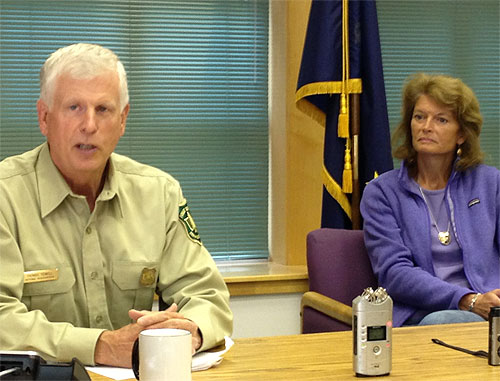
Forest Service Chief Tours Tongass with Murkowski
August 13, 2013
After touring communities of the Tongass, Murkowski said she hopes Tidwell leaves with a recognition that in his role, it's not just about management of the trees, it's about management of the economy of a region. The visit to Southeast Alaska will give Tidwell an opportunity to observe first-hand some of the challenges faced by those living on the country's largest national forest.
Friday in Ketchikan, U.S. Forest Service Chief Tom Tidwell and U.S. Sen. Lisa Murkowski highlighted two recently awarded woody biomass grants to organizations in Haines and Ketchikan.
Meeting with the press Friday morning in Ketchikan, Murkowski and Tidwell highlighted two recently awarded woody biomass grants to organizations in Haines and Ketchikan. The grants, comprising $180,000 collectively, will fund wood-to-energy projects using timber from the Tongass National Forest and surrounding areas. The stop was part of a two-day trip to learn, listen and engage with small and emerging rural businesses in rural communities throughout Southeast Alaska. Murkowski met with Tidwell to be briefed on the progress of numerous opportunities and investments in Southeast communities and also to work to bring strategic investments and well-paying jobs to the region. “The communities of Southeast have always been dependent on the responsible harvest of timber from the Tongass, which covers nearly every mile of the Panhandle. Unfortunately, for a number of reasons, the forest industry has been in decline for the past 20 years. We simply must find a way to increase the amount of timber we harvest from the Tongass to ensure that these communities remain viable. Small projects like the biomass ones we’re talking about today are part of the solution, but they are not the complete answer,” Murkowski said. “My hat’s off to the communities of Haines and Ketchikan for their leadership and commitment to additional investments in their transition to new energy sources,” Tidwell said. “They both have articulated clear visions for their energy futures and are being rewarded as trail blazers throughout the Southeast communities as an example for others to follow.” These two communities have also implemented additional wood to energy conversion projects including:
The efforts in Haines and Ketchikan align with the goals of the Forest Service and the State of Alaska to shift the energy economies of Southeast communities from heating with fossil fuels, to heating with regionally-sourced renewable energy--specifically biomass energy. The Forest Service is also conducting numerous feasibility studies on government facilities in Southeast to pilot these technologies for conversion to wood energy and to assist our communities with generating market demand for biomass products. In Ketchikan, the Ketchikan Gateway Borough received $143,363 for both the Ketchikan high school and the airport terminal to fund the design for conversion of the heating systems from heating oil to biomass fuel. The Ketchikan conversion project continues to move the community closer to a tipping point where biomass becomes a self-supporting energy industry with significant private sector investment. Once an adequate amount of demand is created, the supply and infrastructure investments can take place to meet that demand. The Forest Service goal over the next decade is to support a transition of 30 percent of the regional heating oil usage to biomass energy. The high school, with a biomass fuel demand approaching 1,000 tons per year, is a significant step toward that goal. In Haines, The Chilkoot Indian Association received $35,000 to design a community wood pellet mill to meet local demand for home heating. Future projections will target markets in Juneau and Canada by using sawmill residue from wood sourced from the Haines State Forest, and beetle-killed wood from the Yukon. The economics of a pellet mill in northern Southeast Alaska are compelling. Pellets barged in from the Lower 48 and British Columbia are considerably more cost effective than heating with diesel oil, yet nearly half of the cost of those imported pellets is attributable to shipping. By establishing their own local wood-fuel refinery, Haines should see a significant reduction in the cost of pellets by eliminating the shipping component, with the added benefit of the creation of local jobs and economic activity from retaining energy money in the community. The development of the Haines mill demonstrates the principle of “demand leading supply.” The Borough of Haines’ decision to convert the local senior center to wood-pellet heat has been an economic success story. In Alaska, there are more than 100 communities that are accessible only by air or water. The prices of petroleum fuel in these communities are among the highest in the nation. In 2012, heating oil prices in some remote communities, where winter temperatures can reach 60 below zero, exceeded $10 per gallon, due largely to transportation costs. Some villages have had to close public facilities because they cannot afford to heat them. Tidwell is the 17th and Current Chief of the United States Forest Service (USFS) of the Department of Agriculture, and was appointed on July 17, 2009.
Edited by Mary Kauffman, SitNews
Source of News:
E-mail your news &
photos to editor@sitnews.us
|
||
